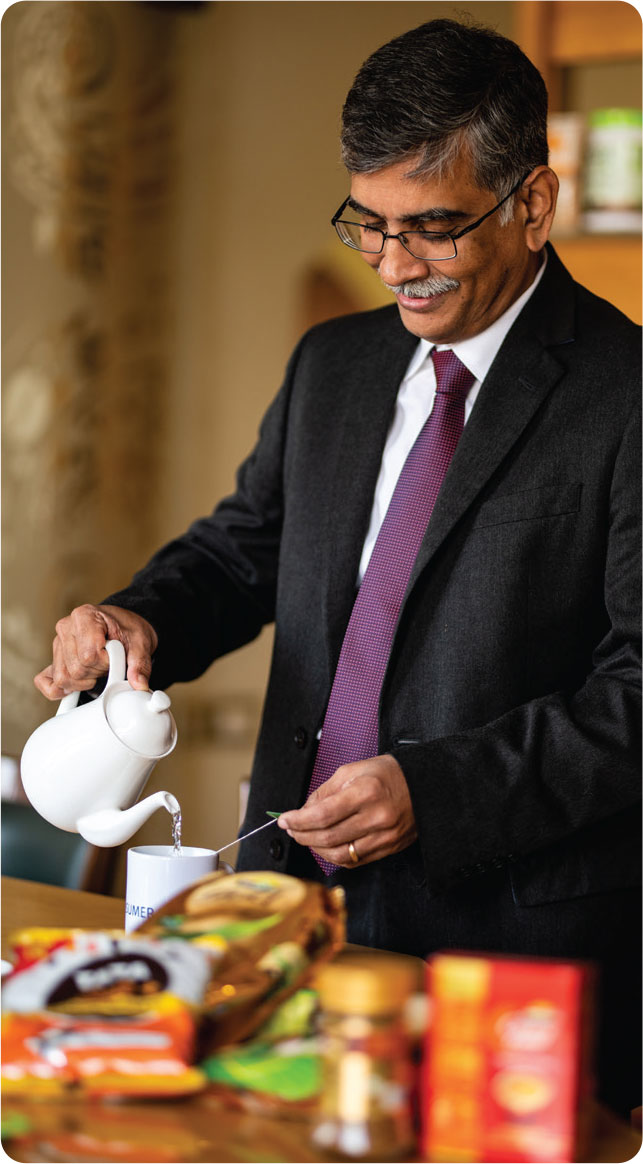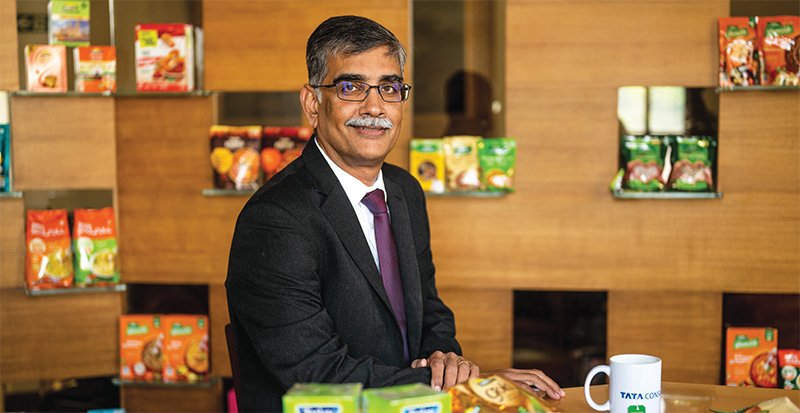
Q&A with MD and CEO
Doubling down
on execution

Over the last three years we have built capabilities and laid a solid foundation that has propelled us and will stand us in good stead as we strive for accelerated growth.
Q IT HAS BEEN THREE YEARS SINCE THE FORMATION OF TATA CONSUMER, AND ITS TRANSFORMATION JOURNEY. CAN YOU BEGIN BY GIVING US AN OUTLINE OF THE PROGRESS MADE?
Our transformation journey to becoming a leading FMCG Company is well on track; we have laid a solid foundation and built capabilities for accelerated growth. We are staying true to our strategy and executing against it. Our defined roadmap is based on our strategic goals and guides our planning and execution.
Our total addressable market is now larger, our core businesses are enhanced, and we are future-ready, more than ever before.
We now directly reach 1.5 million outlets with an overall reach of 3.8 million outlets, and growing. We are embedding digital deep into our value chain, from the front-end salespeople to the supply chain, operations, procurement, and backend. This provides us with data for building strong analytics across the business.
Our capabilities are scalable and can be applied to new categories or businesses that we may pursue. Our growth businesses i.e., Tata Sampann, NourishCo, and Tata Soulfull, are growing well. We are going beyond our core (which has been strengthened), and focusing on building new F&B platforms that will create a greater presence across categories.
To ensure future readiness, we are also investing in talent and recalibrating the organisation structure to be more scalable and robust.
We have been fostering an environment of innovation that puts the consumer first, which has helped us increase our innovation-to-sales ratio to 3.4% in FY 22-23, from just 0.8% in FY 19-20.
Our focus on building a strong and sustainable domestic business has resulted in India contributing 71% to our branded revenue in FY 22-23 from 62% in FY 19-20. Our growth businesses have also scaled remarkably well, growing over 50% this fiscal.
We have been working to create efficiencies in all aspects of our business, for instance, we have reduced working-capital days to 35 at the end of FY 22-23 from 59 at the end of FY 19-20.
QFMCG COMPANIES HAVE FACED NUMEROUS CHALLENGES THIS YEAR DUE TO VARIOUS EXTERNAL FACTORS AND RURAL DEMAND CHALLENGES. HOW DID YOU COPE?
The macro environment was indeed challenging due to geopolitical tensions, decadal-high inflation hurting demand and consumer choices, monetary tightening, and rising interest rates, impacting the global economy. These impacted our raw material and other costs, especially in the international business.
Yet, we remained focussed on execution and strengthened the foundations of our businesses to support long-term growth.
Our Salt business grew in strong double digits and its three-year CAGR is 19%.
While the Tea business was subdued due to a slowdown in some key markets, the three-year CAGR for Packaged Beverages is still tracking at 10%. Our premiumisation agenda is on track with several new launches in the branded Coffee portfolio, which grew 31%.
Our growth businesses grew 53% this year, and we are expanding our portfolio by adding new vectors of growth. We accelerated the pace of innovation, with an average of three new launches a month. Our ‘Fit for Future’ infrastructure with an R&D Centre of Excellence in Bengaluru, will add further impetus to our innovation agenda.
Finally, we are focusing on cost and efficiency by simplifying, streamlining and synergising our businesses, as seen with the Tata Coffee merger that is underway.
Q HOW DID ALL OF THIS TRANSLATE INTO OVERALL BUSINESS AND FINANCIAL PERFORMANCE?
We reported 11% topline growth, with a 7% increase in EBITDA, which was impacted by significant inflation in our Salt and International business. The India business grew by 10%, with growth businesses i.e., NourishCo, Tata Sampann, and Tata Soulfull accounting for 15% of our India business. Importantly, the EPS grew by 28%. We also achieved robust free cash flow conversion. If you take our 3 year history, we grew revenue and EBITDA at a CAGR of 17% and 13% respectively, despite pandemic-related challenges.
During the year, the Salt business grew at a strong double-digit rate, with new innovative products like Tata Salt Immune, Tata Salt + Vitamin Shakti, and Tata Salt Pink Salt.
The International business grew at a high single-digit rate accounting for a little over 25% of overall revenue. There, the profitability was impacted by input cost inflation and adverse currency movements, and we have taken pricing actions to correct this are seeing strong sequential recovery in margins. More importantly, we have injected high quality talent in the leadership team there and have implemented structural changes to reduce costs.
Our JV, Tata Starbucks, added 71 new stores during the year, bringing the total to 333 stores across 41 cities and the business was EBITDA positive.
QYOU MENTIONED THAT THE GROWTH BUSINESSES ACCOUNT FOR 15% OF THE INDIA BUSINESS. WHAT IS DRIVING GROWTH HERE?
Our growth businesses have all grown strongly, and we will continue to drive them further.
Under Tata Sampann, we have strengthened our core portfolio of pulses, spices and other staples. We forayed into South India with custom spice blends. We have also expanded into premium categories like Dry Fruits and increased our readyto-eat (RTE) and ready-to-cook (RTC) offerings, through Tata Sampann Yumside (formerly Tata Q) making a larger play into the Pantry space.
NourishCo, our Liquid beverages business, has recorded significant topline growth. Revenues increased 3.5x from c.INR 180 crores in FY 19-20 (when it was converted from a JV to a wholly owned subsidiary) to INR 621 crores in FY 22-23. We achieved this by expanding distribution, building higher capacity through co-packers and introducing new products which now contribute 13% to the business. Tata Copper+ brand has achieved exponential growth due to its unique proposition, and the Himalayan brand has turned profitable, enabling expansion into newer products such as Honey and Preserves.
Our millets business – Tata Soulfull – has grown almost threefold since we acquired it in 2021, propelled by synergies with our distribution system. With 2023 being the International Year of Millets, Tata Soulfull is in a strong position to capitalise on this opportunity by increasing the awareness and accessibility of this portfolio.
QHOW IS THE SALES AND DISTRIBUTION EXPANSION AGENDA COMING ALONG, AND WHAT NEXT?
We have rapidly expanded our distribution network, growing 3 fold from ~ 0.5 million outlets in direct reach in 2020 to 1.5 million outlets currently.
Modern Trade and E-commerce have been instrumental in driving our growth, with E-commerce contributing 9% of India business in FY 22-23, up from c.2.5% in FY 19-20. Modern Trade has grown by 21% this fiscal and contributed 14% of India business sales.
E-commerce’s Innovation to Sales contribution exceeded the company average of 3.4%, standing at 10%.
We have also started making progress in expanding the rural and semi-urban reach, with increased direct-distributor coverage in semi-urban areas and split routes in larger towns driving assortment and growth. Our wholesale directoutlet coverage has doubled, and an incentive programme has been instituted to maximise the wholesale network’s potential.
We are now looking to appoint distributors in all towns with a population of 50K+ and a large number of high-income towns with 20k+ population. The implementation of the split routes in towns with a population of 10 lakhs+ will enhance bandwidth for the salesforce at the front end. Overall, we are on track to achieve a total reach of 4 million outlets by 2023, and we will continue to launch channel-specific initiatives to maintain momentum.

QWHAT ARE THE KEY CONSUMER TRENDS YOU SEE POST COVID? HOW DO YOU SEE THESE TRENDS INFLUENCING TATA CONSUMER’S BUSINESS?
Our focus on key consumer trends such as health and wellness, convenience, and digital adoption is driving our innovation agenda, marketing, and sales and distribution strategies.
In the past couple of years, we have launched several products in India business to cater to the growing health and wellness trend, including Tetley Immune with Vitamin C, Tata Tea Gold Care, Chakra Gold Care, Tata Salt Immuno, Tata Salt + Vitamin Shakti, Tata Salt Lite, Tata Salt Super Lite, Tata Salt Iron Health, and Tata Rock Salt.
Tata Sampann offers unpolished pulses and spices with natural oils, and we have introduced a range of Dry Fruits. This year we have also entered the Protein category with plant-based meat under the brand Tata Simply Better and plant protein powder under Tata GoFit.
Tata Soulfull’s entire portfolio is built around health and wellness. Tata Soulfull Masala Oats+ has 25% Millets and Ragi Bites No Maida Choco has the goodness of ragi and other grains without refined flour.
In our Liquids platforms, Tata Copper+ and Himalayan are part of our wellness portfolio.
To take advantage of the convenience trend, we have launched RTC and RTE products under the Tata Sampann Yumside brand, as well as new branded coffee offerings such as Tata Coffee Cafe Specials and the Cold Coffee range.
Finally, to capitalise on the digital adoption trend, we have strengthened our online presence through e-commerce and directto-customer (D2C) channels. Our omnichannel strategy allows us to provide consumers with a seamless shopping experience across multiple touchpoints. We have a D2C presence for Tata Soulfull, Tata Tea 1868, Sonnets, and Tata Gofit. In addition, our D2C website www.tatanutrikorner.com, offers all our brands in India on a single platform, enhancing convenience for consumers. We are currently available in select cities and plan to expand our reach further.
QYOU HAVE STEPPED UP YOUR FOCUS ON INNOVATION THIS YEAR AND ENTERED NEW CATEGORIES. WHAT IS THE THINKING BEHIND THAT, AND DO YOU SEE THIS PLAYING OUT TO YOUR EXPECTATIONS?
We have taken a strategic approach to identifying key platforms we want to play in. After evaluating several factors, including market opportunity, category growth, profitability, our capabilities including distribution and R&D, and our overall competitive edge, we’ve narrowed the universe down to five key platforms—Current core (tea, coffee, salt), Pantry (pulses, spices, staples, RTCs, dry fruits), Liquids (water, RTD), Mini meals (breakfast cereals, RTEs, snacks), and Protein platform (plant-based meat, plant protein powder). This framework enables us to develop a targeted understanding of our consumers, enhance our internal capabilities, innovate within established parameters, expand our total addressable market, and tap into new consumption occasions.
As a result, we have entered new categories, launched differentiated products, and added significant value to our portfolio extensions. Our pace of innovation has increased, leading to improved financial performance and several marginaccretive launches.
We have also invested in state of the art R&D infrastructure in Bengaluru, Mumbai, and Sri City to future-proof our innovation capabilities, which has resulted in almost doubling the number of launches in FY 22-23 compared to FY 21-22 and increased our Innovation to Sales ratio to 3.4%.
Q YOU MENTIONED THE INTENTION TO SIMPLIFY AND SYNERGISE THE BUSINESS. CAN YOU PROVIDE AN UPDATE ON THE PROGRESS OF THESE INITIATIVES?
We have been on a journey of simplifying, scaling and synergising our businesses since 2020. A key initiative is the merger of Tata Coffee with Tata Consumer - expected to conclude in 2023. It entails demerging Tata Coffee’s plantations business into a wholly-owned subsidiary of Tata Consumer, and integrating its coffee extractions business with our tea- extraction business.
This will allow us to strengthen our product offerings and unlock market potential by widening the portfolio and geographic reach.
Our legal structure is also being simplified and we are targeting to almost halve the number of legal entities that we currently have. This will help unlock operational efficiencies and enables faster decision-making, execution, and result in significant savings. Similar initiatives are underway in our international business too.
We have undertaken restructuring initiatives in our international business to boost competitiveness, including organisational cost reductions and establishing a shared services centre to streamline backend operations and reduce costs.
Q WHAT ARE YOUR PLANS FOR THE INTERNATIONAL BUSINESSES?
In our key international markets of the US, UK and Canada, we have a sizeable share in the black-tea segment which we are revitalising with innovation and impactful marketing.
We are also strengthening our nonblack portfolio by focusing on Fruit, Herbal and Specialty teas. We have adopted a three-brand strategy centred around Tetley, Good Earth, and teapigs to cover the entire tea market.
In the US coffee business, we are expanding our play in the fastestgrowing K-cup segment and pursuing further distribution opportunities.
To tap into the fast-growing Indian Ready Foods segment in International markets, we recently introduced Tata Raasa, which offers ethnic RTE and RTC meals inspired by traditional regional recipes from India.
Over the past few years, we have sharpened our strategy in key markets, exiting marginal or noncore operations. Most recently we have restructured our operating model in Bangladesh and exited the previous joint venture. We have also increased our stake in the Joekels tea business in South Africa.

To be successful, we recognise the need to be strategic and choiceful about where we invest our resources. While FMCG offers a large landscape of opportunities, we will focus on areas where we can win and add value, taking into account various factors such as category growth, profitability, and competitive intensity among others.
Q WHAT ARE THE SUSTAINABILITY GOALS AND INITIATIVES OF TATA CONSUMER? WHAT PROGRESS HAS BEEN MADE IN THIS AREA?
Sustainability is emerging as a crucial factor in consumers’ buying decisions, and this trend is shaping businesses. It is also increasingly becoming a key consideration for all stakeholders, including shareholders, employees, and business partners. Therefore, our sustainability strategy has been informed by various sources, including the UN’s Sustainability Development Goals (SDGs), materiality analysis conducted with a broad crosssection of our stakeholders, industry trends, regulatory requirements, and science-based targets.
In FY 22-23, we released our ESG report, which lays out our Sustainability Strategy ‘For Better Living’ and encompasses four key areas: For Better Nutrition, For Better Sourcing, For a Better Planet and For Better Communities. It includes a set of commitments to achieving netzero status, water neutrality, circular economy of plastics, diversity in the workforce, sustainable products, and sustainable sourcing among others.
These commitments are also completely aligned to the Tata Group’s sustainability vision and goals under Project Aalingana.
Q HOW ARE YOU STRENGTHENING THE TEAM AND CULTURE?
We have prioritised attracting and retaining top talent in significant roles and functions while simultaneously enhancing organisational capability. For instance, we recently brought in new business heads in the UK and the US and a D2C Head in India, to execute our growth roadmap. It is critical to have a competent and driven team across all levels. We are also creating a robust talent pipeline for the future with our management trainee programme and robust processes in talent management and succession planning.
Additionally, we have increased our focus on Learning and Development, and in mapping learning interventions to key organisational capabilities. We are committed to inclusivity in our culture, and have initiated programmes to develop an inclusive culture and such as sensitisation programmes, employee resource groups, and diversity-friendly policies, to drive this further.
Q FINALLY, WHAT ARE YOUR KEY PRIORITIES GOING FORWARD?
The top priority has to be growing through strengthening the existing business and expanding into F&B adjacencies. We will keep working on our transformation, and building capabilities to achieve sustainable and profitable growth, leading to a virtuous flywheel of stronger return ratios.
To be successful, we recognise the need to be strategic and choiceful about where we invest our resources. While FMCG offers a large landscape of opportunities, we will focus on areas where we can win and add value, taking into account various factors such as category growth, profitability, and competitive intensity among others.
We will continue to assess new segments and categories based on their potential, and will take the inorganic route where necessary, to acquire capabilities we do not possess or need to develop quickly, as long as they meet our strategic and financial filters and align with our long-term objectives.
Tata Consumer is on a journey to create long term value for all stakeholders, and I can say that there is a lot to look forward to.
Sunil D’Souza MD and CEO
